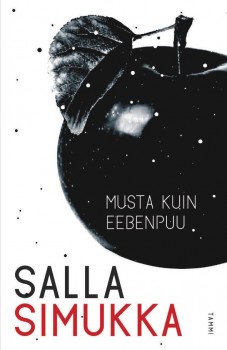Is less really more? On new books for young readers
18 December 2014 | Articles, Non-fiction

Black as ebony: volume three of the ‘Snow White’ trilogy for young adults by Salla Simukka
This year has been an eventful for Finnish literature in many ways, not least in terms of young adults’ and children’s books. The full ramifications of Finland’s turn as the theme country at this year’s Frankfurt Book Fair will only be known with the passage of time, but more mega-success stories to stand alongside Salla Simukka’s Lumikki (Snow White, Tammi) trilogy for young adults – now sold to almost 50 countries – are eagerly awaited. Visitors to the Frankfurt Book Fair also got a look at Finland-Swedish illustration at the By/Kylä (‘Village’) stand, which presented varied works by nine illustrators and animators in a memorable exhibit.
Book sales continue to fall in Finland. The major general-interest publishers – WSOY, Tammi, and Otava – have cut back on Finnish titles and are concentrating on high-sellers and proven authors.
Books in series are now a dominant phenomenon in literature for children and young adults, aiming to win readers’ loyalty with their continuing stories and characters. Many longtime authors and illustrators of books for children and young adults have had to look for new contacts, and publishers are increasingly hesitant to launch debut artists.
Alternative forms of publishing have become more important in the quest to champion experimental and innovative children’s literature. Etana (‘Snail’) Editions, a new publishing house dedicated to books for small children, has used crowd funding to release two picture books, Yksi vielä (‘One more’) by Réka Király, and Värejä meressä (‘The colours in the sea’) by Jenni Erkintalo.
Building markets and professional networks is the greatest challenge for smaller publishers. Books North, formed in conjunction with Agency North, which specialises in drama, invested considerable resources in publicity for two picture books by Iiro Küttner and Ville Tietäväinen, an effort which resulted in ample media attention.
The Finlandia Junior, Finland’s largest prize for children’s literature, created a stir when one of the six nominees chosen was Min egen lilla liten (‘My own tiny little thing’, Schildts & Söderströms), a picture book by Linda Bondestam based on a text by Swedish author Ulf Stark. Helsingin Sanomat newspaper and the Lastenkirjahylly (‘Children’s bookshelf’) book blog criticised the selection for promoting a Swedish author when so many Finnish children’s authors receive little pay and less media attention.
Maria Turtschaninoff, this year’s Finlandia Junior Prize winner, has written five novels since 2006, and all have opened up new and captivating worlds for readers. Turtschaninoff treats her target audience with respect: ‘Writing for young people is special. When you’re young, literature affects you more powerfully than it does adults,’ the author said in an interview in Helsingin Sanomat.
On a visit to Finland in the autumn of 2014, the American author William G. Brozo sparked discussion of the need for better reading instruction for boys. Another author who is himself quite young, Aleksi Delikouras (born 1990), known for his Nörtti (‘Nerd’, Otava) trilogy, has campaigned on behalf of increased reading practice for boys in schools and libraries, pointing out that boys hooked on computer games from a young age need to experience the same success and reinforcement in reading that they get from game play.
Lukuinto (‘Passion to read’), a project funded by the Ministry of Education and Culture, will end in spring of 2015. Its objectives are to create practical models for developing the reading and writing skills of primary and secondary-school pupils and strengthening the media training, knowledge and methods used by teachers and librarians to support varied reading and writing skills and interests. The programme also emphasises the importance of media literacy.
Worries over the reduction in leisure time spent reading among children and youth also call for broad research on reading with an emphasis on providing literature education beginning in early childhood.
Translated by Lola Rogers
We will publish a selection of short reviews of particularly original and interesting books for children and young adults in 2014 in January after our winter break.
No comments for this entry yet
